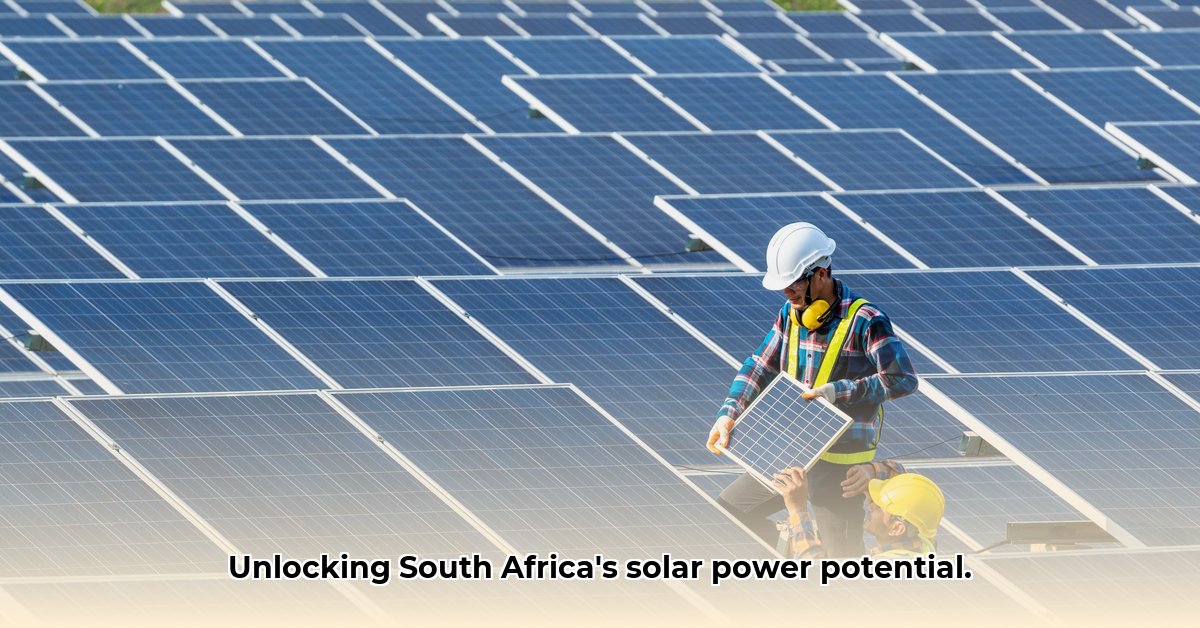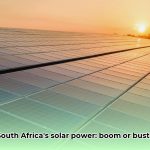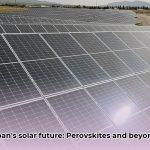South Africa stands at the cusp of a solar revolution, brimming with potential yet facing considerable hurdles. This article delves into the intricacies of the South African solar energy landscape, exploring its vast opportunities and the obstacles that must be overcome to achieve a sustainable energy future. We will analyze the key trends, examine the challenges, and propose actionable strategies for unlocking the full potential of solar power in the nation. To understand daily solar panel output, see this helpful resource on solar panel energy production.
The Solar Energy Landscape in South Africa: An Overview
South Africa’s solar energy sector is experiencing exponential growth, driven by a confluence of factors, including the declining cost of solar photovoltaic (PV) technology, supportive government policies, and an increasing demand for reliable and clean energy sources. The country’s abundant solar resources, with high levels of irradiance, make it an ideal location for solar energy generation.
Installed solar capacity in South Africa has seen a dramatic increase in recent years. As of July 2024, the nation boasted 2,287 MW of utility-scale PV solar power connected to the grid, alongside 5,791 MW of rooftop solar installations and 500 MW of Concentrated Solar Power (CSP). Projections indicate a continued upward trajectory, with installed capacity expected to reach 8,400 MW by 2030.
Government Initiatives and Regulatory Framework
Recognizing the transformative potential of solar energy, the South African government has implemented various initiatives to incentivize its adoption. A significant step was the introduction of tax incentives through the South African Revenue Service (SARS) in 2016, aimed at promoting the installation of photovoltaic solar energy generation systems.
Section 12B of the Income Tax Act No. 58 of 1962 provides a tax shield through accelerated depreciation for commercial entities investing in solar PV systems. Systems smaller than or equal to 1 MWp (Megawatt peak) can be depreciated in a single year, offering a 28% discount on the system’s cost. Larger systems, exceeding 1 MWp, are depreciated over three years, with a schedule of 50%, 30%, and 20% in the first three years, respectively.
Furthermore, certain municipalities have introduced their own incentives, such as feed-in tariffs or net metering, to encourage residential and commercial customers to adopt solar energy.
Key Challenges and Obstacles
Despite the promising outlook and supportive measures, the South African solar energy sector faces several challenges that hinder its full potential.
Conflicting Stakeholder Interests
The solar energy landscape in South Africa is characterized by a complex interplay of stakeholders with often divergent interests. Eskom, the state-owned electricity utility, which supplies 90% of South Africa’s electricity, has voiced concerns about the potential impact of renewable energy on its revenue stream and the potential displacement of jobs in the coal industry.
Eskom’s reliance on coal-fired power stations and its financial dependence on electricity sales create a conflict of interest, as the growth of solar energy poses a direct threat to its traditional business model. However, many municipalities actively promote solar energy through incentives and support programs.
Regulatory and Bureaucratic Hurdles
The regulatory framework governing solar energy in South Africa is often perceived as cumbersome and inconsistent. Obtaining approvals for grid connection, particularly for small-scale embedded generation (SSEG) systems, can be a lengthy and complex process, discouraging potential adopters.
The lack of a streamlined and standardized registration process for SSEG systems creates uncertainty and delays, hindering the widespread adoption of rooftop solar installations.
Financial and Equity Concerns
While the cost of solar energy has declined significantly in recent years, affordability remains a significant barrier for low- and middle-income households. The upfront investment required for solar PV systems can be prohibitive for many, exacerbating existing social inequalities.
Ensuring equitable access to solar energy benefits requires targeted financial assistance, innovative financing solutions, and community-based solar programs to address the affordability gap.
Grid Infrastructure Limitations
The existing grid infrastructure in South Africa poses a challenge to the integration of large-scale solar energy. The grid’s capacity to accommodate intermittent renewable energy sources, such as solar, is limited in some areas, requiring significant upgrades and investments.
Modernizing the grid to enhance its capacity and flexibility is essential to facilitate the seamless integration of solar energy and other renewable energy sources.
Strategies for Accelerating Solar Energy Adoption
To overcome these challenges and unlock the full potential of solar energy in South Africa, a comprehensive and collaborative approach is required, involving government, Eskom, renewable energy companies, municipalities, and consumers.
Streamlining Regulations and Approvals
The government should prioritize the streamlining of regulations and approval processes for solar energy projects, particularly for SSEG systems. This includes simplifying the registration process, reducing bureaucratic hurdles, and establishing clear and consistent guidelines.
A one-stop-shop approach, providing a single point of contact for all regulatory requirements, can significantly reduce the time and cost associated with solar energy project development.
Grid Modernization and Investment
Significant investments are needed to modernize and upgrade the grid infrastructure to accommodate the increasing influx of solar energy. This includes enhancing grid capacity, improving grid stability, and implementing smart grid technologies.
Public-private partnerships can be leveraged to mobilize the necessary capital for grid modernization projects, ensuring a reliable and resilient electricity network.
Innovative Financing Solutions
To address the affordability barrier, innovative financing solutions are needed to make solar energy accessible to a wider range of consumers. This includes offering low-interest loans, leasing options, power purchase agreements (PPAs), and community-based solar programs.
Government subsidies, tax incentives, and rebates can also play a crucial role in reducing the upfront cost of solar PV systems, making them more attractive to low- and middle-income households.
Collaboration and Stakeholder Engagement
Effective collaboration and stakeholder engagement are essential for driving the solar energy transition in South Africa. This includes fostering open communication and collaboration between Eskom, renewable energy companies, municipalities, and consumers.
Regular dialogues, workshops, and forums can help to address concerns, build trust, and identify mutually beneficial solutions.
Skills Development and Job Creation
The growth of the solar energy sector presents a significant opportunity for skills development and job creation. Investing in training programs and educational initiatives can equip individuals with the skills needed to participate in the solar energy industry.
This includes training for solar PV installation, maintenance, and repair, as well as for project management and finance.
Eskom’s Role in the Energy Transition
Eskom’s role in the energy transition is critical. The utility needs to adapt to the changing energy landscape and embrace renewable energy as a key component of its future strategy.
This includes investing in renewable energy projects, modernizing its grid infrastructure, and exploring innovative business models that leverage the potential of solar energy.
Eskom can also play a crucial role in facilitating the integration of solar energy into the grid, ensuring grid stability and reliability.
Financing Solar: Options for Residential Consumers
For residential consumers, several financing options exist to make solar energy more accessible.
Direct Loans: Offer competitive interest rates, requiring upfront capital.
Rent-to-Own Plans: Ease financial burden but impact long-term ownership.
Bank Financing (Third-Party Installers): Facilitated through installers, dependent on creditworthiness.
Bank Loans (Personal Installers): Increase flexibility but require upfront planning.
Choosing the right option depends on budget and long-term goals.
Commercial Solar: Overcoming Barriers to Investment
Commercial solar adoption faces financial hurdles, policy inconsistencies, and grid limitations. Addressing these challenges requires incentives, streamlined regulations, and grid upgrades. The sector offers environmental sustainability, social equity, and energy security.
Conclusion: A Brighter Future Powered by the Sun
South Africa has the potential to become a leader in solar energy, driving economic growth, creating jobs, and ensuring a sustainable energy future.
By addressing the challenges, implementing effective strategies, and fostering collaboration among stakeholders, South Africa can unlock the full potential of solar energy and power a brighter future for all its citizens. The transition to renewable energy is not merely an option but a necessity for a sustainable and prosperous future.
- Hydro Extrusions USA Leads North American Aluminum Profile Solutions - December 28, 2025
- Hydro North America Leads Aluminum Extrusion Solutions Across Diverse Industries - December 27, 2025
- Hydro Extrusion North America Provides Custom Solutions Across Diverse - December 26, 2025
















